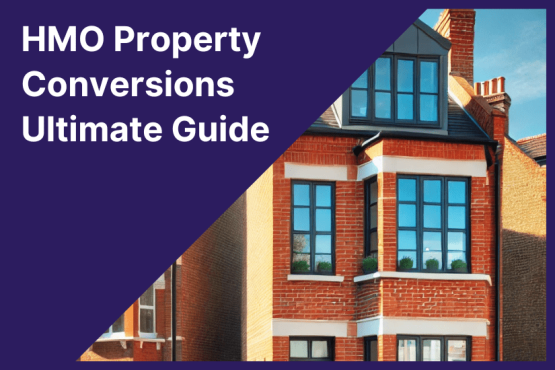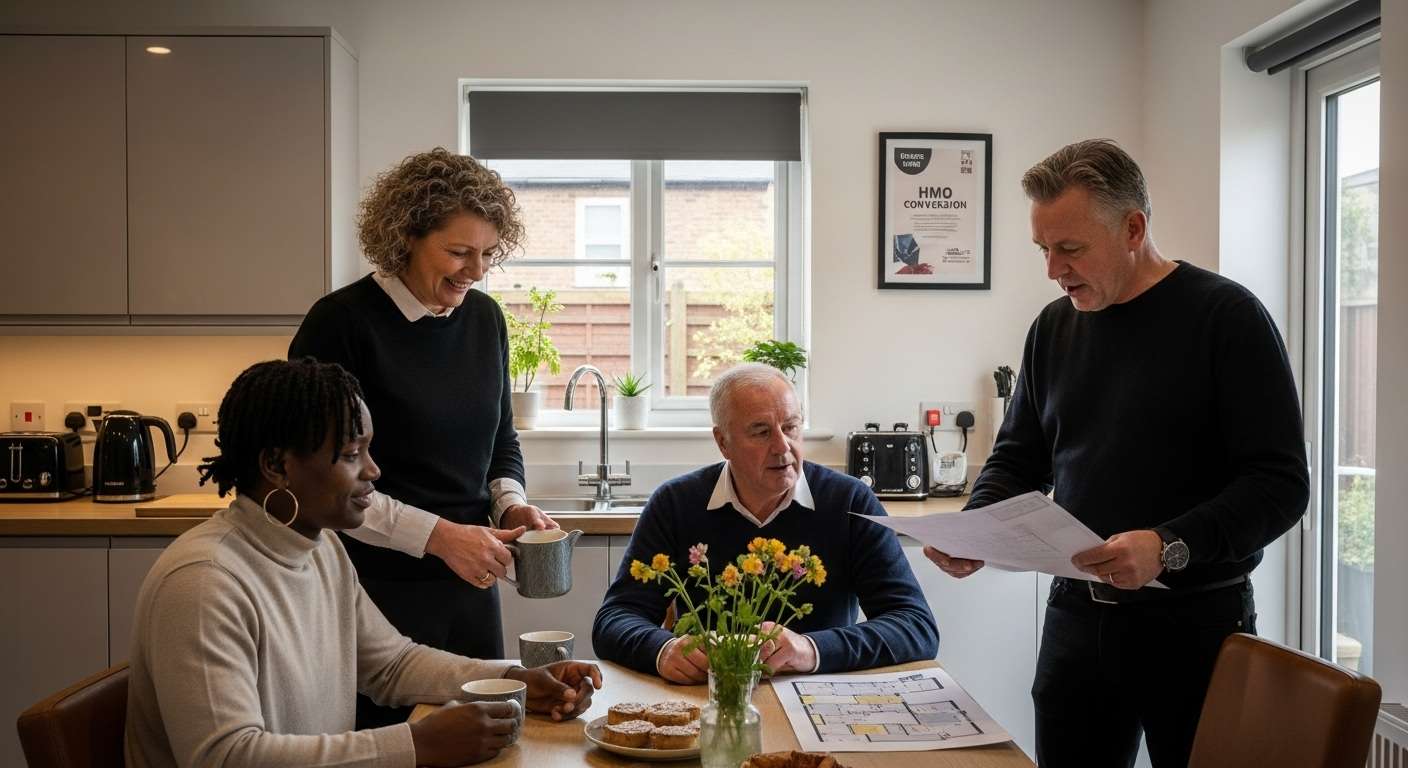What is an HMO Conversion?
An HMO conversion is a process of changing a property’s use class to a House in Multiple Occupation (HMO), allowing multiple tenants to rent individual rooms in shared living spaces.
HMO conversions can provide higher rental income and a more efficient way to manage a rental portfolio.
However, they also come with specific regulations, safety standards, and licensing requirements. It is crucial to understand and comply with HMO fire regulations due to the heightened fire risks associated with HMOs.
HMO Conversion Costs and Finance
The cost of converting a property into an HMO can vary, but it’s typically around £10,000 to £40,000.
Financing options include refinancing or remortgaging the property, bridging loans, or specialist HMO mortgages.
It’s essential to consider the costs and potential returns on property investment before embarking on an HMO conversion. Converting a property into a HMO can be a strategic response to financial pressures, offering higher rental yields if the property meets the necessary legal requirements.
Planning Permission for HMO Conversions
Planning permission is required from the local council before starting an HMO conversion, as it often involves a change of use. It is crucial to obtain HMO planning permission to avoid legal issues and potential fines.
The rules about planning permission vary by location and property size, but it’s always required for HMOs with seven or more unrelated people.
Check with your local council to determine if planning permission is needed for your specific property.
HMO Building Regulations and Safety Requirements
HMO conversions must comply with specific building regulations and safety standards, including fire safety, electrical safety, and gas safety. Housing standards are also a critical aspect to consider during these conversions.
The local authority will carry out a Housing Health and Safety Rating System (HHSRS) risk assessment to identify any issues. Local authorities play a crucial role in enforcing these building regulations and conducting safety inspections.
It’s essential to work with an expert, such as an architect or builder, to ensure compliance with regulations.
Obtaining an HMO Licence
An HMO licence is required for properties renting to five or more people who form more than one household. The licensing process for obtaining an HMO license is necessary to comply with legal requirements, and operating without one can result in significant legal implications.
The licence application requires specific details, including proof of identity, mortgage, and photo ID.
The application cost starts at £750, and the licence holder must be a fit and proper person.
Market Analysis and Demand for HMOs
Converting a property into an HMO can be a lucrative investment, but it’s essential to understand the local market demand before embarking on such a project. Here are some key points to consider:
Research the Local Area: Understanding the demographics, population growth, and housing demand in the area is crucial. This will help you determine if there is a need for HMOs and what type of tenants you can expect to attract. Look into local statistics and trends to get a clear picture of the potential market for your HMO property.
Analyze the Competition: Take a close look at the existing HMOs in the area. Assess their occupancy rates, rental income, and amenities. This will give you an idea of what prospective tenants are looking for and how you can differentiate your property. Understanding your competition will help you position your HMO to stand out in the market.
Identify Your Target Market: Determine what type of tenants you want to attract, such as students, young professionals, or families. This will help you tailor your marketing strategy and amenities to meet their needs. Knowing your target market will guide your decisions on room sizes, communal spaces, and additional services.
Assess the Local Economy: The local economy, including the job market, transportation links, and amenities, plays a significant role in attracting tenants. Ensure the area is attractive to tenants and that they will be able to afford the rent. A strong local economy with good employment opportunities and convenient transport links will make your HMO more appealing.
By conducting a thorough market analysis, you can determine if converting a property into an HMO is a viable investment opportunity and make informed decisions about the conversion process.
Maximizing Rental Income from HMOs
HMOs can provide higher rental income due to multiple tenants renting individual rooms. Tenants pay rent for individual rooms, leading to increased rental yields and monthly income.
The average return on investment for HMOs is around 7.5%, surpassing the typical 3.63% return from traditional buy-to-let properties.
It’s essential to research the local market and understand the demand for HMOs in your area.
HMO Room Conversions and Layout
Regulations stipulate minimum room sizes, including 4.64 sq m for children under 10 and 6.51 sq m for tenants over 10.
One bathroom should be provided for every four tenants.
It’s essential to plan the layout carefully to maximize the number of rooms, communal areas, and rental income. Such a conversion can increase rental income and reduce dependency on a single tenant, but it also requires compliance with regulations, safety standards, and obtaining the appropriate planning permissions.
Sustainability and Energy Efficiency in HMOs
As a responsible landlord, it’s essential to consider the sustainability and energy efficiency of your HMO property. Here are some key points to consider:
Energy-efficient Appliances: Installing energy-efficient appliances, such as LED lighting and low-flow showerheads, can significantly reduce energy consumption and lower utility bills. These appliances not only benefit the environment but also make your property more attractive to eco-conscious tenants.
Insulation: Ensuring that the property is well-insulated is crucial to reducing heat loss and energy consumption. Proper insulation can lead to lower heating costs and a more comfortable living environment for your tenants.
Renewable Energy Sources: Consider installing renewable energy sources, such as solar panels or a biomass boiler, to reduce your carbon footprint and energy bills. Renewable energy can be a selling point for environmentally-conscious tenants and can also provide long-term savings.
Water Conservation: Installing low-flow taps and toilets can help reduce water consumption and lower water bills. Water-saving fixtures are an easy way to make your property more sustainable and cost-effective.
Recycling: Encourage tenants to recycle by providing recycling bins and facilities. Promoting recycling practices can help reduce waste and appeal to tenants who prioritize sustainability.
Sustainable Materials: Using sustainable materials, such as reclaimed wood and low-VOC paints, during the conversion process can reduce the environmental impact of your HMO. Sustainable materials are not only better for the environment but can also create a healthier living space for your tenants.
By incorporating sustainable and energy-efficient features into your HMO property, you can reduce your environmental impact, lower your energy bills, and attract environmentally-conscious tenants.
Safety and Smoke Alarms in HMOs
HMO landlords must ensure that all gas appliances are maintained, with a Gas Safe registered engineer carrying out a gas safety check each year.
Smoke alarms and carbon monoxide detectors must be installed, and electrical installations and appliances must be safe to use. It is crucial to comply with HMO fire regulations to ensure tenant safety, which includes conducting comprehensive fire risk assessments and implementing necessary fire safety measures.
Furniture and furnishings provided by the landlord must meet fire-resistance regulations.
Property Alterations and Inspections
Property alterations may be necessary to meet HMO property standards, including installing fire doors, fire alarms, and smoke detectors. Certain alterations may fall under permitted development rights, but local authorities can impose restrictions, such as Article 4 directives, which necessitate acquiring HMO planning permission even when the general rule of permitted development would apply.
Regular inspections are essential to ensure compliance with regulations and to identify any potential issues.
It’s recommended to work with a professional property management company to ensure compliance and maximize rental income.
Common Enquiries and FAQs
What is an HMO conversion, and how does it work?
Do I need planning permission for my HMO conversion?
How much does an HMO licence cost, and what are the requirements? Understanding HMO licensing requirements is crucial as non-compliance can lead to significant fines. Ensure you are aware of the types of licensing available and local regulations.
Can I convert any property into an HMO, or are there specific requirements?
How do I maximize rental income from my HMO?
Conclusion and Next Steps
Converting a property into an HMO can be a lucrative investment opportunity, offering higher rental yields and a more efficient way to manage a rental portfolio. However, it’s essential to comply with specific regulations, safety standards, and licensing requirements to ensure a successful transition.
Before embarking on an HMO conversion, it’s crucial to research the local market and demand for HMO accommodation, consider the initial investment required, and think about the potential risks and challenges involved in managing an HMO.
To ensure compliance with HMO regulations, it’s recommended to work with a reputable property management company or a specialist HMO consultant who can guide you through the process and provide expert advice on HMO licencing, planning permission, and property management.
Additionally, it’s essential to understand the local authority’s requirements and regulations regarding HMO conversions, including the need for planning permission, HMO licences, and mandatory licensing.
By following the guidelines outlined in this HMO conversion guide, prospective tenants can be assured of a safe and comfortable living environment, and landlords can enjoy a profitable and stress-free investment.
In conclusion, converting a property into an HMO can be a rewarding experience for landlords, offering higher rental income and a more efficient way to manage a rental portfolio. However, it’s crucial to comply with specific regulations, safety standards, and licensing requirements to ensure a successful transition.
Next steps:
Research the local market and demand for HMO accommodation
Consider the initial investment required and potential risks and challenges involved in managing an HMO
Work with a reputable property management company or specialist HMO consultant
Understand the local authority’s requirements and regulations regarding HMO conversions
Ensure compliance with HMO regulations, including planning permission, HMO licences, and mandatory licensing
By following these next steps, landlords can ensure a successful HMO conversion and enjoy a profitable and stress-free investment.


